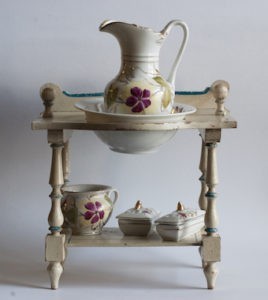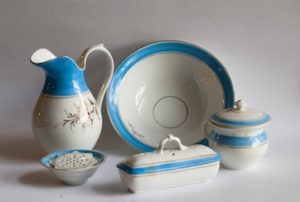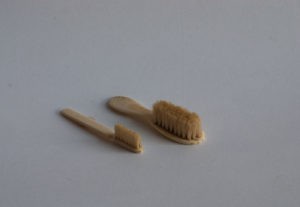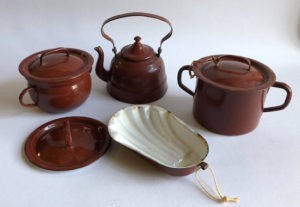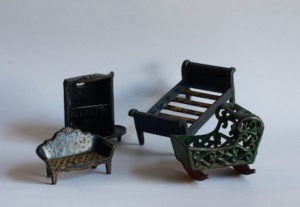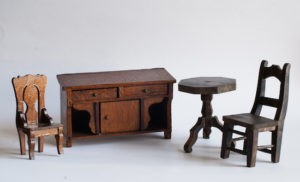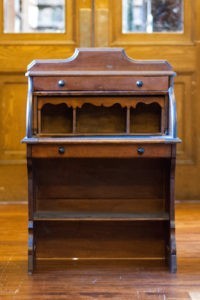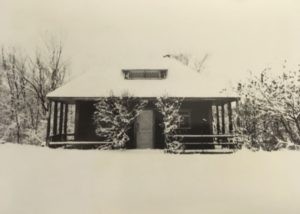Doll’s houses and the miniatures inside them allowed children to play house. Some privileged children, such as Ray and Mary Scott from Breakeyville, Quebec had large doll houses in their backyard that were almost fully functional.
However, even the houses of the wealthy lacked some of the amenities we consider basic today. The Stephens Collection includes two miniature toilet sets from the 19th and 20th centuries. Real-life versions of the fancy porcelain toilet sets were common in the bedrooms of the wealthy in the days before running water. The water jug (called a “ewer”), bowl, and soap dish were used for sponge baths. Most homes did not have flush toilets in the 19th century, and the chamber pot was a portable toilet intended to be used in the bedroom during the night. The perforated rectangular box held a toothbrush, which typically had a bone handle and animal bristles.
The blue toilet set pictured here belonged to Aldythe Thom (b.1893). She was the granddaughter of William Thom (b.1825), who founded Professor Thom’s Practical Mercantile Academy on rue Sainte-Angèle. This Protestant-run school was so successful among Catholics that the Brothers of the Christian Schools opened up a rival Commercial Academy across the street to ensure young Catholics stayed within the faith.
-
TOY TOILET SET
Late 19th- early 20th century, unknown
Porcelain
Belonged to Wilma Hoare
Stephens Collection 2004-172 (toilet set)
Stephens Collection 2004-173 (stand)
Stand: 24.4 x 21 x 24.9 cm
-
TOY TOILET SET
c. 1890, probably Germany
Porcelain
Belonged to Aldythe Thom
Stephens Collection 2004-169
Various sizes
-
TOY BRUSHES
c. 1880, unknown
Bone and fibre
Belonged to the Strang family
Stephens Collection 2004-278
Toothbrush: 1.2 x 7.8 x 1 cm
Brush: 1.6 X 8.3 x 2.2 cm
-
TOY KITCHEN SET
Late 19th-early 20th century, unknown
Enamelled tin
Belonged to the Scott and Breakey families
Stephens Collection 2004-175
Various sizes
-
MINIATURE TOY FURNITURE SET
c. 1840-1850, unknown
Iron
Belonged to Robertson family
Stephens Collection 2004-282, 2004-283, 2004-284, 2004-285
Various sizes
-
MINIATURE TOY FURNITURE SET
c. 1920, likely Canada
Wood and metal
Stephens Collection 2004-298
Various sizes
-
CHILD’S ROLLTOP DESK
c. 1900, likely Quebec City
Wood and metal
Stephens Collection 2004-181
87.9 x 37.5 x 61.3 cm
-
“THE DOLL’S HOUSE”
c. 1910, Breakeyville
Belonged to the Breakey and Scott families
Stephens Collection 2004-289
Excerpts from writings by Mary Hilda Freeland Stephens:
“Many of the toy dishes and pots and pans came from the playhouse at Mon Abri. This was the name of the home of the family of Lieut. Col. James Scott in Breakeyville, across the river from Quebec on the south shore. The playhouse was always called The Dolls’ House; it was built at the turn of the century […] Though a miniature house, there are two floors, a real staircase, a real kitchen where food was cooked on a small wood-burning stove. […] That little stove continued in service in Mary Scott Warrington’s kitchen until the mid-1980s. The Dolls’ House was built for her older sister, Ray (Mrs. ‘Cousie’ (Clifford) Price). I have the child-size roll-top desk with pigeon holes and drawer which came from the playhouse.” (Mary Hilda Freeland Stephens, My Quebec Collection, 11)
